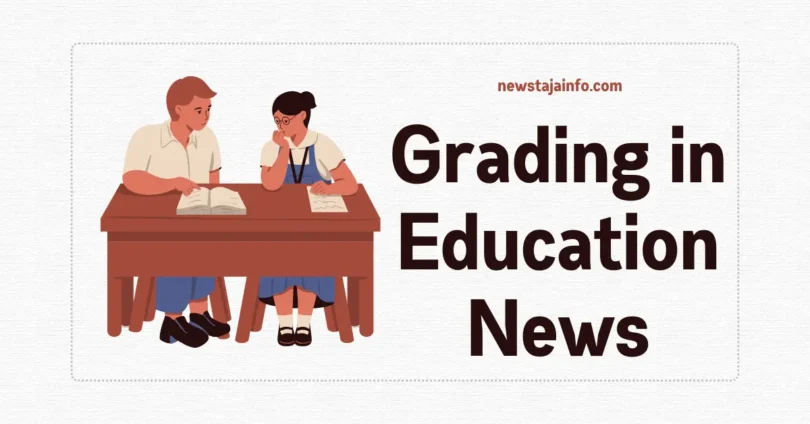Welcome to News Taja Info – We discover and share the latest updates on news, admit cards, exam results, and answer keys. Count on us for fast and trusted information.
Grading in education news has become a hot topic in recent years. As schools and universities across the world adopt new systems, many students, parents, and teachers are wondering how these changes will affect learning. From online report cards to flexible grading policies, the way we evaluate student performance is evolving. This article explores the latest updates, global trends, and expert opinions related to grading in education news all explained in simple words that everyone can understand.
What Is Grading in Education and Why It Matters
Grading in education news is gaining more attention than ever before. Grading refers to the system schools and colleges use to measure a student’s performance, learning, and progress. It helps teachers understand how well a student is doing and guides parents in supporting their child’s education. But in today is fast changing world, grading systems are evolving and so is the news around them.
Many countries are rethinking how they grade students. With more awareness of student stress, learning gaps, and online education, grading is no longer just about marks and percentages. It’s about fairness, accuracy, and supporting better learning outcomes. In this article, we explore everything you need to know about grading in education news from old systems to the future of grading.
The Evolution of Grading Systems: A Brief History
Grading systems have come a long way from the old days. Earlier, teachers would write personal notes or comments about each student. But over time, schools needed a more standardized way to assess learning.
Historical Milestones:
- 1800s: Letter grades (A, B, C) were introduced in U.S. schools.
- 1900s: Percentage systems became popular across Europe and Asia.
- 1950s–2000s: GPA (Grade Point Average) system took over in universities.
- 2000s onwards: Narrative grading, portfolio-based assessments, and digital grading became more common.
Types of Grading Systems Used Around the World
Each country has its own style of grading. Here’s a look at the most widely used systems:
Letter Grades (A–F):
- Common in the USA, Canada, and parts of the UK.
- Example: A = Excellent, B = Good, C = Average, D = Poor, F = Fail
Percentage-Based Grades:
- Widely used in India, Pakistan, and other Asian countries.
- Example: 90%–100% = A+, 80%–89% = A, etc.
GPA (Grade Point Average):
- Used in the U.S. and many universities globally.
- Ranges from 0.0 to 4.0 or 5.0 scale.
CGPA (Cumulative GPA):
- Common in CBSE schools in India.
- Measures the overall performance over several terms.
Narrative Grading:
- Teachers give written feedback instead of marks.
- Focuses on learning skills and personal growth.
Pass/Fail System:
- Mostly in practical training, internships, or during the COVID-19 crisis.
Recent Trends and News in Educational Grading
Grading in education news is full of updates and reforms. Here are some of the major highlights:
Key News Trends:
- Flexible Grading Policies: Many schools adopted no-fail or optional grading during the pandemic.
- AI in Grading: Artificial Intelligence is being used to check assignments and exams.
- Digital Report Cards: Online grading systems are replacing traditional report cards.
- Skill-Based Assessment: Grading now focuses on skills, creativity, and understanding—not just memorization.
How COVID-19 Impacted Grading Systems Globally
COVID-19 changed how education works. Students stayed at home, classes went online, and exams were canceled or delayed. Naturally, grading also changed.
Major Impacts:
- Online Tests: Schools introduced online quizzes and open-book exams.
- No Exams, Only Assignments: Some institutions skipped exams and graded students based on homework.
- Pass/Fail Only: Many universities gave only pass/fail grades during lockdowns.
- Mental Health Considerations: Grading was made softer to reduce pressure.
The Role of Technology in Modern Grading
Technology has become a big part of grading in education.
Tools and Platforms:
- Google Classroom: Teachers give grades, feedback, and track performance.
- Moodle & Canvas: Widely used in universities for digital assessments.
- AI Graders: Some software can check grammar, give scores, and provide instant feedback.
Benefits:
- Speeds up grading
- Reduces human error
- Allows students to view results anytime
- Supports personalized learning
Pros and Cons of Current Grading Systems
Every grading system has its strengths and weaknesses.
Pros:
- Easy to compare student performance
- Motivates students to work harder
- Helps in school or college admissions
- Gives a clear picture of progress
Cons:
- Adds stress and pressure on students
- May not reflect true learning
- Encourages rote learning
- Unfair to students with different learning styles
How Grading Affects Students’ Mental Health and Motivation
Grades are more than numbers they affect how students feel.
Effects on Mental Health:
- Anxiety before exams and results
- Fear of failure and competition
- Low self-esteem due to poor grades
Positive Motivation:
- Clear goals to aim for
- Encouragement when performance improves
- Pride in academic achievement
But this only works when grading is fair and supportive not harsh.
Experts Views on Reforming Grading Systems
Educational experts are now recommending changes to grading systems.
Expert Suggestions:
- Focus on learning not marks
- Include project work, class activities, and life skills
- Use continuous assessment throughout the year
- Offer written feedback, not just numbers
Many education ministries around the world are considering these ideas to improve student learning.
Real-Life Examples: Countries That Changed Their Grading Systems
🇫🇮 Finland:
- No standard tests till high school
- Uses teacher feedback and student projects
🇸🇬 Singapore:
- Removed class rankings
- Focus on holistic development
🇮🇳 India:
- Introduced NEP 2020 with competency-based grading
- Emphasis on understanding, not memorizing
Students’ Perspective: What They Think About Grading
Common Student Opinions:
- “I wish grades were based on effort too.”
- “Sometimes my test doesn’t show how much I know.”
- “Projects and group work should be graded too.”
- “I get too nervous during exams.”
Listening to students is key when improving grading methods.
Teachers’ and Parents’ Role in the Grading Process
Teachers Should:
- Give regular feedback
- Use fair rubrics for marking
- Explain grading criteria clearly
Parents Can:
- Encourage effort, not just results
- Help with time management and study skills
- Talk openly about grades and improvements
When teachers and parents work together, students benefit the most.
Future of Grading in Education
The future of grading is exciting and more student-centered.
What to Expect:
- Personalized learning assessments
- Digital portfolios instead of report cards
- AI-based learning support
- Less focus on exams, more on everyday learning
- Mental health-friendly policies
Education systems are moving toward fairness, flexibility, and student well-being.
Tips for Students: How to Understand and Improve Your Grades
Practical Tips:
- Always review your teacher’s feedback
- Ask questions when confused
- Work on weak areas regularly
- Practice time management
- Use online tools to test yourself
- Focus on learning, not just scoring
Improving grades is about consistency and a positive mindset.
Common FAQs About Grading in Education News
Some faqs of grading in education news:
1. What is grading in education?
Grading in education is the process of measuring and recording a student’s performance in school or college.
2. Why is grading important?
It helps track student progress, motivates learners, and assists in academic placement.
3. Which grading system is best?
There is no single best system. It depends on the student, school, and country.
4. How did COVID-19 change grading?
Many schools switched to online, flexible, or pass/fail grading due to lockdowns.
5. Are letter grades better than percentages?
Letter grades are easier to understand, but percentages show exact performance. Both have their uses.
6. What is GPA and how is it calculated?
GPA (Grade Point Average) is the average of grades on a scale, often 4.0 or 5.0.
7. Can technology replace teacher grading?
Technology helps, but teacher judgment is still very important for fair and accurate grading.
8. What is narrative grading?
It is when teachers write feedback instead of giving marks or grades.
9. Does grading cause stress?
Yes, especially when students feel too much pressure to perform.
10. Will grading systems change in the future?
Yes, many countries are planning reforms for fairer and more student-friendly grading.
Conclusion
Grading in education news shows us that the way we measure student success is changing. From traditional exams and percentage scores to flexible grading, digital tools, and personalized feedback, the world of education is growing fast. These changes are not just about numbers—they are about creating a system that is fair, helpful, and focused on real learning.
Today, experts, teachers, students, and parents all agree on one thing grading should support learning, not hurt it. Good grading systems should reduce pressure, recognize individual progress, and help every student grow in their own way. Countries around the world are starting to adopt these ideas, and that’s a positive step forward.
As we move into the future, grading must continue to adapt. With the help of technology and better policies, we can create a system that encourages curiosity, supports mental health, and truly reflects what a student knows and can do. It’s time to make grading a tool for growth not fear.
Written By: News Taja Info







